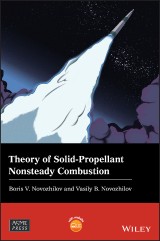Details

Theory of Solid-Propellant Nonsteady Combustion
Wiley-ASME Press Series 1. Aufl.
|
121,99 € |
|
| Verlag: | Wiley |
| Format: | |
| Veröffentl.: | 21.08.2020 |
| ISBN/EAN: | 9781119525646 |
| Sprache: | englisch |
| Anzahl Seiten: | 352 |
DRM-geschütztes eBook, Sie benötigen z.B. Adobe Digital Editions und eine Adobe ID zum Lesen.
Beschreibungen
Despite significant developments and widespread theoretical and practical interest in the area of Solid-Propellant Nonsteady Combustion for the last fifty years, a comprehensive and authoritative text on the subject has not been available. Theory of Solid-Propellant Nonsteady Combustion fills this gap by summarizing theoretical approaches to the problem within the framework of the Zeldovich-Novozhilov (ZN-) theory. This book contains equations governing unsteady combustion and applies them systematically to a wide range of problems of practical interest. Theory conclusions are validated, as much as possible, against available experimental data. Theory of Solid-Propellant Nonsteady Combustion provides an accurate up-to-date account and perspectives on the subject and is also accompanied by a website hosting solutions to problems in the book.
<p>About the Authors</p> <p>Preface</p> <p>Abbreviations</p> <p><b>CHAPTER I STEADY-STATE COMBUSTION </b></p> <p>1.1 General Characteristics of Solid Propellants</p> <p>1.2 Burning Rate and Surface Temperature</p> <p>1.3 Combustion Wave Structure.Burning temperature</p> <p>1.4 Combustion in Tangential Gas Stream </p> <p>1.5 Gaseous flame</p> <p>1.6 Combustion Wave in Condensed Phase</p> <p>1.7 The Two Approaches to the Theory of Nonsteady Propellant Combustion</p> <p>1.8 Steady-State Belyaev Model</p> <p><b>CHAPTER II EQUATIONS OF THE THEORY OF NONSTEADY COMBUSTION </b></p> <p>2.1 Major Assumptions</p> <p>2.2 Zeldovich Theory. Constant Surface Temperature</p> <p>2.3 Variable Surface Temperature</p> <p>2.4 Integral Formulation of the Theory</p> <p>2.5 Theory Formulation through the set of Ordinary Differential Equations</p> <p>2.6 Linear Approximation</p> <p>2.7 Formal Mathematical Justification of the Theory</p> <p><b>CHAPTER III COMBUSTION UNDER CONSTANT PRESSURE </b></p> <p>3.1 Stability Criterion for a Steady-state Combustion Regime</p> <p>3.2 Asymptotical Perturbation Analysis</p> <p>3.3 Two-dimensional Combustion Stability of Gasless Systems</p> <p>3.4 Combustion Beyond Stability Region</p> <p>3.5 Comparison to Experimental Data</p> <p><b>CHAPTER IV COMBUSTION UNDER HARMONICALLY OSCILLATING PRESSURE </b></p> <p>4.1 Linear Burning Rate Response to Harmonically Oscillating Pressure</p> <p>4.2 Acoustic Admittance of Propellant Surface</p> <p>4.3 Quadratic Response Functions</p> <p>4.4 Acoustic Admittance in the Second-order Approximation</p> <p>4.5 Nonlinear Resonance</p> <p>4.6 Response Function Bifurcations</p> <p>4.7 Frequency – Amplitude Diagram</p> <p>4.8 Comparison to Experimental Data</p> <p><b>CHAPTER V NONSTEADY EROSIVE COMBUSTION </b></p> <p>5.1 Problem formulation</p> <p>5.2 Linear Approximation</p> <p>5.3 Nonlinear Effects in Nonsteady Erosive Combustion</p> <p><b>CHAPTER VI NONSTEADY COMBUSTION UNDER EXTERNAL RADIATION</b></p> <p>6.1 Steady-state Combustion Regime</p> <p>6.2 Heat Transfer Equation in the Linear Approximation</p> <p>6.3 Linearization of Nonsteady Burning Laws</p> <p>6.4 Steady-state Combustion Regime Stability</p> <p>6.5 Burning Rate Response to Harmonically Oscillating Pressure</p> <p>6.6 Burning Rate Response to Harmonically Oscillating Radiative Flux</p> <p>6.7 Relation between Burning Rate Responses to Harmonically Oscillating Pressure and Radiative Flux</p> <p><b>CHAPTER VII NON-ACOUSTIC COMBUSTION REGIMES. EXTINCTION</b></p> <p>7.1 Acoustic and Non-acoustic Combustion Regimes</p> <p>7.2 Linear Approximation</p> <p>7.3 Approximate Approach in the Theory of Nonsteady Combustion</p> <p>7.4 Self-similar Solution</p> <p>7.5 Self-similar Solution Stability</p> <p>7.6 Propellant Combustion and Extinction under Depressurization. </p> <p>Constant Surface Temperature.</p> <p>7.7 Propellant Combustion and Extinction under Depressurization. </p> <p>Variable Surface Temperature.</p> <p><b>CHAPTER VIII MODELING NONSTEADY COMBUSTION IN SOLID ROCKET MOTOR</b></p> <p>8.1 Introduction</p> <p>8.2 Non-acoustic Regimes. Problem Formulation</p> <p>8.3 Stability of Steady-state Regime in a Semi-enclosed Volume</p> <p>8.4 Transient Regimes</p> <p>8.5 Unstable and Chaotic Regimes</p> <p>8.6 Experimental Data</p> <p>8.7 Acoustic Regimes</p> <p>8.8 Automatic Control of Propellant Combustion Stability in a Semi- enclosed Volume</p> <p><b>CHAPTER IX INFLUENCE OF GAS-PHASE INERTIA ON NONSTEADY COMBUSTION</b></p> <p>9.1 Introduction</p> <p>9.2 Steady-state Combustion Regime Stability</p> <p>9.3 Burning Rate Response to Harmonically Oscillating Pressure</p> <p>9.4 Acoustic Admittance of Propellant Surface</p> <p>9.5 Combustion and Extinction under Depressurization</p> <p>9.6 approximation</p> <p>References</p> <p>Problems</p> <p>Problem Solutions</p> <p>Subject Index</p>
<p><b>Professor Boris V. Novozhilov</b> (1930-2017), Chief Researcher, The Semenov Institute of Chemical Physics, Russian Academy of Sciences, Moscow. <p><b>Professor Vasily B. Novozhilov,</b> Professor of Mathematics, Discipline of Science, Research Institute for Sustainable Industries and Liveable Cities, Victoria University, Melbourne Victoria, Australia.
<p><b>Theory of Solid-Propellant Nonsteady Combustion</b> <p><b>The leading theoretical examination of solid-propellant nonsteady combustion</b> <p><i>Theory of Solid-Propellant Nonsteady Combustion</i> is the first authoritative and comprehensive monograph on the subject available to researchers and students of the field. This book contains equations governing unsteady combustion and applies them systematically to a wide range of practical problems. Theory conclusions are validated, as much as possible, against available experimental data. <i>Theory of Solid-Propellant Nonsteady Combustion</i> provides an accurate, up-to-date account of the subject. It is also accompanied by a website which provides solutions to the exercises found in the book. <p>Co-authored by one of the creators of the Zeldovich – Novozhilov Theory the book includes, among others, discussions of: <ul> <li>Combustion properties of solid propellants</li> <li>Fundamentals and mathematical formulation of the Zeldovich – Novozhilov (ZN) Theory</li> <li>Combustion in steady and unsteady pressure environments</li> <li>Combustion beyond stability region</li> <li>Acoustic and non-acoustic combustion regimes, including extinction</li> <li>Extension of the Theory beyond conventional ZN approximations</li> </ul> <p>Perfect for researchers and practitioners in the aerospace industry and graduate students in mechanical and aerospace engineering, this text provides a complete, fundamental, and invaluable resource to all those who work and study in the area.
Diese Produkte könnten Sie auch interessieren:

Turbulent Drag Reduction by Surfactant Additives

von: Feng-Chen Li, Bo Yu, Jin-Jia Wei, Yasuo Kawaguchi

156,99 €

Turbulent Drag Reduction by Surfactant Additives

von: Feng-Chen Li, Bo Yu, Jin-Jia Wei, Yasuo Kawaguchi

156,99 €














